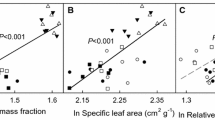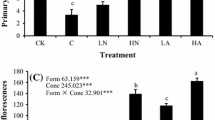Abstract
Global environmental change and ongoing biological invasions are the two prominent ecological issues threatening biodiversity worldwide, and investigations of their interaction will aid to predict plant invasions and inform better management strategies in the future. In this study, invasive Eupatorium adenophorum and native congener E. stoechadosmum were compared at ambient and elevated atmospheric carbon dioxide (CO2) concentrations combined with three levels of nitrogen (N; reduced, control and increased) in terms of growth, energy gain, and cost. Compared with E. stoechadosmum, E. adenophorum adopted a quicker-return energy-use strategy, i.e. higher photosynthetic energy-use efficiency and shorter payback time. Lower leaf mass per area may be a pivotal trait for the invader, which contributed to an increased N allocation to Rubisco at the expense of cell walls and therefore to higher photosynthetic energy gain. CO2 enrichment and N deposition synergistically promoted plant growth and influenced some related ecophysiological traits, and the synergistic effects were greater for the invader than for the native congener. Reducing N availability by applying sugar eliminated the advantages of the invader over its native congener at both CO2 levels. Our results indicate that CO2 enrichment and N deposition may exacerbate E. adenophorum’s invasion in the future, and manipulating environmental resources such as N availability may be a feasible tool for managing invasion impacts of E. adenophorum.




Similar content being viewed by others
Abbreviations
- A growth :
-
Photosynthetic rate measured at growth CO2 concentration
- CC:
-
Construction cost
- Cell wall-N:
-
Proportion of leaf N allocated to cell walls
- LMA:
-
Leaf mass per area
- PEUE:
-
Photosynthetic energy-use efficiency
- Rubisco-N:
-
Proportion of leaf N allocated to Rubisco
References
Albert KR, Ro-Poulsen H, Mikkelsen TN, Michelsen A, van der Linden L, Beier C (2011) Interactive effects of elevated CO2, warming, and drought on photosynthesis of Deschampsia flexuosa in a temperate heath ecosystem. J Exp Bot 12:4253–4266
Baruch Z, Goldstein G (1999) Leaf construction cost, nutrient concentration, and net CO2 assimilation of native and invasive species in Hawaii. Oecologia 121:183–192
Bleier JS, Jackson RD (2007) Manipulating the quantity, quality, and manner of C addition to reduce soil inorganic N and increase C4:C3 grass biomass. Rest Ecol 15:688–695
Blumenthal DM, Jordan NR, Russelle MP (2003) Soil carbon addition controls weeds and facilitates prairie restoration. Ecol Appl 13:605–615
Bradford MA, Schumacher HB, Catovsky S, Eggers T, Newingtion JE, Tordoff GM (2007) Impacts of invasive plant species on riparian plant assemblages: interactions with elevated atmospheric carbon dioxide and nitrogen deposition. Oecologia 152:791–803
Corbin JD, D’Antonio CM (2004) Can carbon addition increase competitiveness of native grasses? A case study from California. Restor Ecol 12:36–43
Daehler CC (2003) Performance comparisons of co-occurring native and alien invasive plants: implications for conservation and restoration. Annu Rev Ecol Evol Syst 34:183–211
Davis MA, Grime JP, Thompson K (2000) Fluctuating resources in plant communities: a general theory of invasibility. J Ecol 88:528–534
Dukes JS, Mooney HA (1999) Does global change increase the success of biological invaders? Trends Ecol Evol 14:135–139
Dukes JS, Chiariello NR, Loarie SR, Field C (2011) Strong response of an invasive plant species (Centaurea solstitialis L.) to global environmental changes. Ecol Appl 21:1887–1894
Feng Y-L, Auge H, Ebeling SK (2007) Invasive Buddleja davidii allocates more nitrogen to its photosynthetic machinery than five native woody species. Oecologia 153:501–510
Feng Y-L, Fu G-L, Zheng Y-L (2008) Specific leaf area relates to the differences in leaf construction cost, photosynthesis, nitrogen allocation and use efficiencies between invasive and noninvasive alien congeners. Planta 228:383–390
Feng Y-L, Lei Y-B, Wang R-F, Callaway RM, Valiente-Banuet A, Inderjit, Li Y-P, Zheng Y-L (2009) Evolutionary tradeoffs for nitrogen allocation to photosynthesis versus cell walls in an invasive plant. Proc Natl Acad Sci USA 106:1853–1856
Feng Y-L, Li Y-P, Wang R-F, Callaway RM, Valiente-Banuet A, Inderjit (2011) A quicker return energy-use strategy by populations of a subtropical invader in the non-native range: a potential mechanism for the evolution of increased competitive ability. J Ecol 99:1116–1123
Funk J, Vitousek P (2007) Resource-use efficiency and plant invasion in low-resource systems. Nature 446:1079–1081
Gill RA, Anderson LJ, Polley HW, Johnson HB, Jackson RB (2006) Potential nitrogen constraints on soil carbon sequestration under low and elevated atmospheric CO2. Ecology 87:41–52
Gilliam FS (2006) Response of the herbaceous layer of forest ecosystems to excess nitrogen deposition. J Ecol 94:1176–1191
Hattenschwiler S, Koner C (2003) Does elevated CO2 facilitate naturalization of the non-indigenous Prunus laurocerasus in Swiss temperate forests? Funct Ecol 17:778–785
He W-M, Yu G-L, Sun Z-K (2011) Nitrogen deposition enhances Bromus tectorum invasion: biogeographic differences in growth and competitive ability between China and North America. Ecography 34:1059–1066
IPCC (2007) Summary for policy makers. In: Solomon S, Qin D, Manning M, Chen Z, Marquis M, Averyt KB, Tignor M, Miller HL (eds) Climate change 2007: the physical science basis. Cambridge University Press, Cambridge
Langley JA, Megonigal JP (2010) Ecosystem response to elevated CO2 levels limited by nitrogen-induced plant species shift. Nature 406:96–99
Lee TD, Tjoelker MG, Reich PB, Russelle M (2003) Contrasting growth response of an N2-fixing and non-fixing forb to elevated CO2: dependence on soil N supply. Plant Soil 255:475–486
Lei Y-B, Feng Y-L, Zheng Y-L, Wang R-F, Gong H-D, Zhang Y-P (2011) Innate and evolutionary advantages of invasive Eupatorium adenophorum over native E. japonicum under ambient and doubled atmospheric CO2 concentrations. Biol Invasions 13:2703–2714
Leishman MR, Thomson VP, Cooke J (2010) Native and exotic invasive plants have fundamental similar carbon capture strategies. J Ecol 98:28–42
Luo Y, Su B, Currie WS, Dukes JS, Finzi A, Hartwig U, Hungate B, McMurtrie RE, Oren R, Parton WJ, Pataki DE, Shaw MR, Zak DR, Field CB (2004) Progressive nitrogen limitation of ecosystem responses to rising atmospheric carbon dioxide. Bioscience 54:731–739
Manea A, Leishman MR (2011) Competitive interactions between native and invasive exotic plant species are altered under elevated carbon dioxide. Oecologia 165:735–744
McDowell SCL (2002) Photosynthetic characteristics of invasive and noninvasive species of Rubus (Rosaceae). Am J Bot 89:1431–1438
Nagel JM, Huxman TE, Griffin KL, Smith SD (2004) CO2 Enrichment reduces the energetic cost of biomass construction in an invasive desert grass. Ecology 85:100–106
Norby RJ, Warren JM, Iversen CM, Garten CT, Medlyn BE, McMurtrie RE (2010) CO2 enhancement of forest productivity constrained by limited nitrogen availability. Proc Natl Acad Sci USA 107:19368–19373
Ordonez A, Wright IJ, Olff H (2010) Functional differences between native and alien species: a global-scale comparison. Funct Ecol 24:1353–1361
Osunkoya OO, Bayliss D, Panetta FD, Vivian-Smith G (2010) Leaf trait co-ordination in relation to construction cost, carbon gain and resource-use efficiency in exotic invasive and native woody vine species. Ann Bot (London) 106:371–380
Penuelas J, Sardans J, Llusià J, Owen SM, Carnicer J, Giambelluca TW, Rezende EL, Waite M, Niinemets U (2010) Faster returns on “leaf economics” and different biogeochemical niche in invasive compared with native plant species. Global Change Biol 16:2171–2185
Perry LG, Blumenthal DM, Monaco TA, Paschke MW, Redente EF (2010) Immobilizing nitrogen to control plant invasion. Oecologia 163:13–24
Poorter H, Pepin S, Rijkers T, De Jong Y, Evans JR, Körner C (2006) Construction costs, chemical composition and payback time of high- and low-irradiance leaves. J Exp Bot 57:355–371
Pyšek P, Richardson DM, Pergl J, Jarošík V, Sixtová Z, Weber E (2008) Geographical and taxonomic biases in invasion ecology. Trends Ecol Evol 23:237–244
Raizada P, Singh A, Rajhubanshi AS (2009) Comparative response of seedlings of selected native dry tropical and alien invasive species to CO2 enrichment. J Plant Ecol 2:69–75
Reich PB, Hobbie SE, Lee T, Ellsworth DS, West JB, Tilman D, Knops JMH, Naeem S, Trost J (2006) Nitrogen limitation constrains sustainability of ecosystem response to CO2. Nature 440:922–925
Sasek TW, Strain BR (1991) Effects of CO2 enrichment on the growth and morphology of a native and an introduced honeysuckle vine. Am J Bot 78:69–75
Scharfy D, Funk A, Venterink HO, Güsewell S (2011) Invasive forbs differ functionally from native graminoids, but are similar to native forbs. New Phytol 189:818–828
Shen X-Y, Peng S-L, Chen B-M, Pang J-X, Chen L-Y, Xu H-M, Hou Y-P (2011) Do higher resource capture ability and utilization efficiency facilitate the successful invasion of native plants? Biol Invasions 13:869–881
Smith SD, Huxman TE, Zitzer SF, Charlet TN, Housman DC, Coleman JS, Fenstermaker LK, Seemann JR, Nowak RS (2000) Elevated CO2 increases productivity and invasive species success in an arid ecosystem. Nature 408:79–82
Song L-Y, Li C-H, Peng S-L (2010) Elevated CO2 increase energy-use efficiency of invasive Wedelia trilobata over its indigenous congener. Biol Invasions 12:1221–1230
Vilà M, Corbin JD, Dukes JS, Pino J, Smith SD (2007) Linking plant invasions to global environmental change. In: Canadell JJ, Pataki DE, Pitelka LF (eds) Terrestrial ecosystems in a changing world. The IGBP series. Springer, Berlin
Wang R, Wang Y-Z (2006) Invasion dynamics and potential spread of the invasive alien plant species Ageratina adenophora (Asteraceae) in China. Divers Distrib 12:397–408
Williams K, Field CB, Mooney HA (1989) Relationships among leaf construction costs, leaf longevity, and light environment in rain-forest plants of the genus Piper. Am Nat 133:198–211
Wright IJ, Reich PB, Westoby M, Ackerly DD, Baruch Z, Bongers F, Cavender-Bares J, Chapin T, Cornelissen JHC, Diemer M, Flexas J, Garnier E, Groom PK, Gulias J, Hikosaka K, Lamont BB, Lee T, Lee W, Lusk C, Midgley JJ, Navas ML, Niinemets U, Oleksyn J, Osada N, Poorter H, Poot P, Prior L, Pyankov VI, Roumet C, Thomas SC, Tjoelker MG, Veneklaas EJ, Villar R (2004) The worldwide leaf economics spectrum. Nature 428:821–827
Ye L-F, Fu X, Ge F (2011) Enhanced sensitivity to higher ozone in a pathogen-resistant tobacco cultivar. J Exp Bot 63:1341–1347
Zhang L, Yang Y-X, Zhan X-Y, Zhang C-J, Zhou S-X, Wu D-X (2010) Responses of a dominant temperate grassland plant (Leymus chinensis) to elevated carbon dioxide and nitrogen addition in China. J Environ Qual 39:251–259
Acknowledgments
The authors are grateful to National Forest Ecosystem Research Station at Ailaoshan for logistic supports, Mr Jin-Hua Qi for assistances in measurements, Dr Jiao-lin Zhang and Dr Yong-jiang Zhang for helps in data analysis. This study was funded by the projects of Natural Science Foundation of China (30830027, 30900220), the Applied Basic Study Project of Yunnan Province (2009CD119).
Author information
Authors and Affiliations
Corresponding author
Additional information
Y. Lei and W. Wang contributed equally to this manuscript.
Rights and permissions
About this article
Cite this article
Lei, Yb., Wang, Wb., Feng, Yl. et al. Synergistic interactions of CO2 enrichment and nitrogen deposition promote growth and ecophysiological advantages of invading Eupatorium adenophorum in Southwest China. Planta 236, 1205–1213 (2012). https://doi.org/10.1007/s00425-012-1678-y
Received:
Accepted:
Published:
Issue Date:
DOI: https://doi.org/10.1007/s00425-012-1678-y




